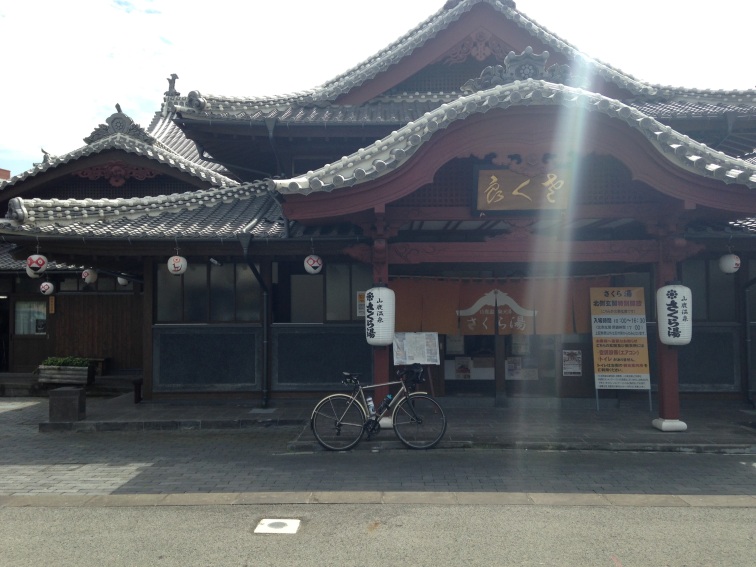This city can be known only by an activity of an ethnographic kind: you must orient yourself in it not by book, by address, but by walking, by sight, by habit, by experience; here every discovery is intense and fragile, it can be repeated or recovered only by memory of the trace it has left in you: to visit a place for the first time is thereby to begin to write it: the address not being written, it must establish its own writing.
So this is how yesterday went:
Woke with the dopey blurry not quite with it thick head that comes when you spend around 15 hours in airliners & airport lounges. Stopped in bed too long with the where am I? what’s going on? why am I cold? and my back hurts head before moving on to the must get it together to get out of here before succumbing to the must prepare for every possible contingency be independent no one will understand you or be able to help you I am on my own and the weather is probably worse than you think head.
When I’m dependent on the bike, the bike must be able to deal with anything. Must be solid. Must not break.
Told myself Get A Plan And Stick To It.
Got the plan and ignored it.
Instead of riding to Harama’s for curry I ride in more or less the opposite direction to The Man who makes the Okonomiyakis.
The Man who makes Okonomiyakis: the man whose door I took off its hinges, well, runners, in 2009. Whose seats I / we spilt more than a litre of water on before taking the door off its runners. Another occasion in Japan in which the space-time continuum contracted. Who bewilderedly accepted a koala from us before we spilled the water. Who made for me not my first but certainly my definitive okonomiyaki. Whose shop is 200 metres from Minshuku Ryokaan Kajita where we first stayed in Kumamoto, from which I now measure all distances in Kumamoto and even Kyushu. Whose okonomiyakis are reliable filling and cheap. Whose television is always tuned to news programs / game shows centred around living and recently dead western celebrities or inert period dramas. Who has not and does not comment on my irregular appearances and resisted my early attempts to know his name—a gift, since wanting to know his name signals my separation from everyday life here. Who remembers that I don’t eat meat but not that I don’t eat seafood. Who has I think given up smoking from the long black cigarette holder while cooking and maybe altogether given up smoking.
I arrrive at his door and open it without incident. The air is clear. Seafoodu, he says. No interrogative. Behind him on the TV breathlessly rapid Japanese commentary overlays images of Bill Clinton speaking at various functions projected over a graphic of a young Prince Charles & Princess Diana. Surely they’re not suggesting?
I was never a fan of Roland Barthes. I came to academia just after his ascendancy in English and Cultural Studies departments. His writing was too cool for me. The fevered ravings of Deleuze & Guattari were for me. Before they were trendy I like to think. So long as they were French.
Barthes wrote in 1982:
The author [himself: Roland Barthes] has never, in any sense, photographed Japan. Rather, he has done the opposite: Japan has starred him with any number of “flashes”; or, better still, Japan has afforded him a situation of writing.*
(Quoting Barthes now signals not that I’m hopelessly out of date & behind the curve but ahead of the game & avant garde.)
Barthes again:
doko ni.
Where indeed. Well there’s always something which’ll make the journey secure. Something to be got. Something more. It’s the more that’s relevant. Getting it is just a way of getting to the more, the anxiety.
After my okonomiyaki breakfast and failing again to understand anything about Japanese TV this day’s more was a bidon.
One attraction, drawback, or trap of hobbies, sports, academia, professions, specialities of any sort is argot. Specialist vocabulary that both facilitates and blocks communication. Signifier-signified, the Symbolic, the Real, the Phallus: bidon, peloton, lanterne rouge, rouleur, souplesse.
A bidon is a water bottle for a bike. Made of stainless steel, aluminium, or, more usually nowadays, some form of plastic, a bidon is designed to fit into the ‘bidon cage’, a stainless steel, titanium, carbon fibre, nylon, or plastic contraption that bolts to the down or seat tube of the bike. Bidons are more efficient means of accessing & carrying water on a bike than sticking a standard water bottle in a pack, or looking for water fountains and / or vending machines. Even in a country where water, soft drink, coffee, tea, whisky, beer and other alcoholic drinks can be found in vending machines in the most remote of places.
I needed the bidon because the part of The Plan I intended to honor come what may was to ride to Yamaga where there is an X hundred years old onsen. ‘X’ because I can’t remember if it’s two, three, or five, and because it doesn’t matter. It is an onsen. It is old.

After the last time I went to it I slept like a baby, something I’m prepared to believe was due to the water, tho it felt like clean, hot water anywhere. The other reason to go to Yamaga is that it is a 60–70 kilometre round trip, a good distance to get rid of cobwebs.